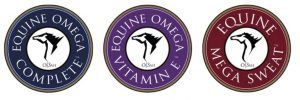Vitamin E: The Antioxidant Powerhouse for Performance and Recovery

Equine Omega Complete contains 1,297 iu’s of all-natural Vitamin E per daily dose of 4 oz.
Equine Omega Vitamin E contains 10,000 iu’s of all-natural Vitamin E per daily dose of 4 oz.
These patented products are complete essential fatty acid (omega) supplements.
Vitamin E plays a vital role in equine health, no matter the level your horse is working at. It is not only essential for maintaining cellular health, but also for immune system support and is critical in protecting the body against oxidative stress caused by intense physical activity. Let’s look at why vitamin E is important, how it works, and how best to ensure your horse is getting enough.
What Is Vitamin E and Why Do Horses Need It?
Vitamin E is a powerful antioxidant that protects cells from damage by neutralizing harmful molecules known as free radicals. These unstable molecules naturally occur during normal metabolism, but their production significantly increases during prolonged intense exercise.
Researchers, including L. Stucchi et al. (2025), have found that skeletal muscle mitochondria, the energy-producing structures in cells, produce large amounts of free radicals during exercise. This sudden increase within the body can overwhelm the horse’s natural antioxidant defenses, which could lead to muscle fatigue, slower recovery, and reduced performance.
To make matters worse, intense exercise may also activate inflammatory pathways. Body-wide inflammation can also be damaging to the horse as free radicals feed inflammation and inflammation in turn increases the level of free radicals in the body. Utilizing antioxidants can help disrupt this cycle and reduce the level of free radicals and inflammation.
Not all free radicals are bad, and some even serve beneficial roles, such as supporting immune responses and enhancing adaptation to exercise. However excessive levels within the body can damage DNA, lipids, proteins, and other cellular components.
Where do horses get Vitamin E?
Vitamin E occurs naturally in fresh pasture, high-quality hay, and fortified feeds. However, the content of vitamin E in feedstuffs is not always sufficient. For example, once hay is cut, vitamin E levels begin to reduce and as much as 50% may be lost within one month of storage. Therefore, those hays stored for even longer may have very little Vitamin E by the time they are fed. Similarly, fresh pasture quality and vitamin E content vary by plant species, season, and even time of day.
Horses on lower amounts-no concentrates, or those relying on stored hay with minimal to no fresh grazing, are at much greater risk of vitamin E deficiency and may require supplementation to maintain optimal health. Generally, 6 months of consistent access to fresh green pasture should be sufficient to avoid the need for supplementation. However, each horse is different, and it’s suggested that testing of the horse’s Vitamin E levels should be carried out before supplementation is provided. In fact, it is good management to test a horse’s levels annually.
Choosing the Right Form of Vitamin E – Natural is Better
Not all vitamin E supplements are created equal. The natural form of vitamin E, known as d-alpha-tocopherol, is significantly more biologically active than synthetic alternatives. Recent studies suggest that natural vitamin E outperforms synthetic vitamin E in reducing oxidative stress and muscle cell damage in athletic horses (Fagan et al, 2017)
Other studies have shown that water-dispersible natural d-alpha-tocopherol increased blood vitamin E levels within just one week, whereas powdered forms took seven weeks to achieve similar effects in horses with low vitamin E status. While both natural and synthetic forms are absorbed by the gut, the liver preferentially distributes natural vitamin E to the tissues where it’s needed most, making it a clear choice when choosing a supplement for your horse.
Synthetic vitamin E will be listed generally as dl-alpha-tocopherol. While it is less bioavailable than the natural form it can still provide adequate levels but would need to be given in higher doses in order to do so.
It should however be noted that more is not always better. If your horse has adequate serum vitamin E levels when tested, there isn’t strong data that says providing more will give additional benefits. Although toxicity risk is low, there is a potential for interference with other fat-soluble vitamins when Vitamin E is over-supplied to the horse. Excessive levels of vitamin E may also impact bone mineralization.
Vitamin E and Omega-3s: The perfect Combo
To further support horses under physical stress, incorporating omega-3 fatty acids can be highly beneficial. Omega-3s not only support heart, joint, and brain health—they also have anti-inflammatory properties that complement the effects of vitamin E.
That’s why our Equine Omega Complete and Equine Omega Vitamin E supplements include both natural d-alpha-tocopherol and omega-3 fatty acids providing a holistic approach to combat oxidative stress, reduce inflammation, and support full-body recovery after work or competition.
Conclusion
Vitamin E is a critical component of your horse’s antioxidant defense. Whether you have a high-performance athlete or a companion on reduced pasture, understanding how vitamin E works and how best to deliver it can make a measurable difference in your horse’s energy, muscle recovery, and overall health.
Questions? jennifer@o3animalhealth.com
Ordering: https://o3animalhealth.com/shop/

References
Fagan, M.M., R. Pazdro, J.A. Call, A. Abrams, P. Harris, A.D. Krotky, and K.J. Duberstein. 2017. Assessment of oxidative stress and muscle damage in exercising horses in response to level and form of vitamin E. Journal of Equine Veterinary Science. 52:80-81.
Brown, J.C, S.J. Valberg, M. Hogg, and D.J. Finno. 2017. Effects of feeding two RRR-alpha-tocopherol formulations on serum, cerebrospinal fluid and muscle alpha-tocopherol concentrations in horses with subclinical vitamin E deficiency. Equine Veterinary Journal. DOI: 10.1111/evj.12692.
McDowell, L.R. 1989. Vitamin E. In: McDowell, L.R. ed. Vitamins in Animal Nutrition. San Diego, CA: Academic Press, Inc.; pp. 93-131.
Stucchi, L., Rossi, R., Mainardi, E., & Ferrucci, F. (2025). Antioxidant capacity and athletic condition of endurance horses undergoing nutraceutical supplementation. Journal of Equine Veterinary Science










